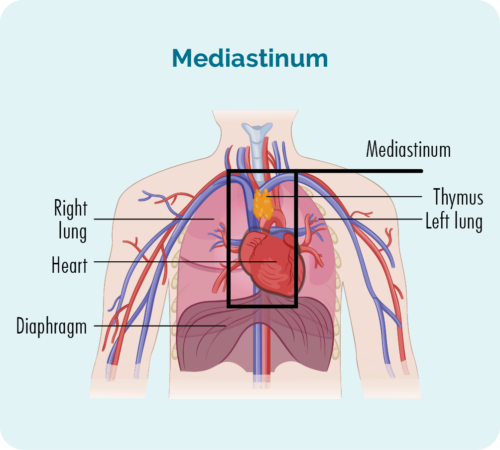B-cell lymphocytes and PMBCL
To understand PMBCL you need to know a bit about your B-Cell lymphocytes.
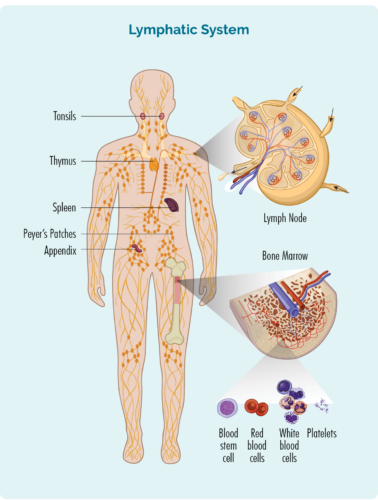
B-Cell lymphocytes:
- Are a type of white blood cell.
- Fight infection and diseases to keep you healthy.
- Make antibodies (also called immunoglobulins) to help fight infection and disease.
- Remember infections you had in the past, so if you get the same infection again, your body’s immune system can fight it more effectively and quickly.
- Are made in your bone marrow (the spongy part in the middle of your bones), but usually live in your spleen and your lymph nodes. Some live in your thymus and blood too.
- Can travel through your lymphatic system, to any part of your body to fight infection or disease.
What happens when B-cells become cancerous?
PMBCL develops when some of your B-cells become cancerous. They grow uncontrollably, are abnormal, and do not die when they should.
When you have PMBCL your cancerous B-cell lymphocytes:
- Will not work as effectively to fight infections and disease.
- Can become larger than they should and can look different to your healthy B-cells.
- Can cause lymphoma to develop and grow in any part of your body.
Can PMBCL be cured?
Although PMBCL is a fast growing (aggressive) lymphoma, many people with PMBCL can be cured with treatment, even if you are diagnosed with stage 3 or 4 lymphoma (advanced stage). An advanced stage of lymphoma is very different to advanced stages of other cancers which cannot be cured.
Causes of PMBCL
We don’t know what causes PMBCL, but we do know that is not infectious and cannot be passed onto other people. It is more common in people aged between 20 to 40 years but can also occur in older children. It is also more common in women than men.
Patient stories - living with PMBCL
Click on the links below to read about Eleisha and Margy’s experiences with PMBCL.
Symptoms of PMBCL
Symptoms of PMBCL may be caused by the lymphoma pressing on the structures in your chest. These may include:
- Cough
- Pain or aching in your chest
- Changes to your voice including hoarseness
- Breathlessness
- Swelling in your neck, face or arms
- Dizziness
- Headaches that are worse when you bend forward
- More visible chest veins
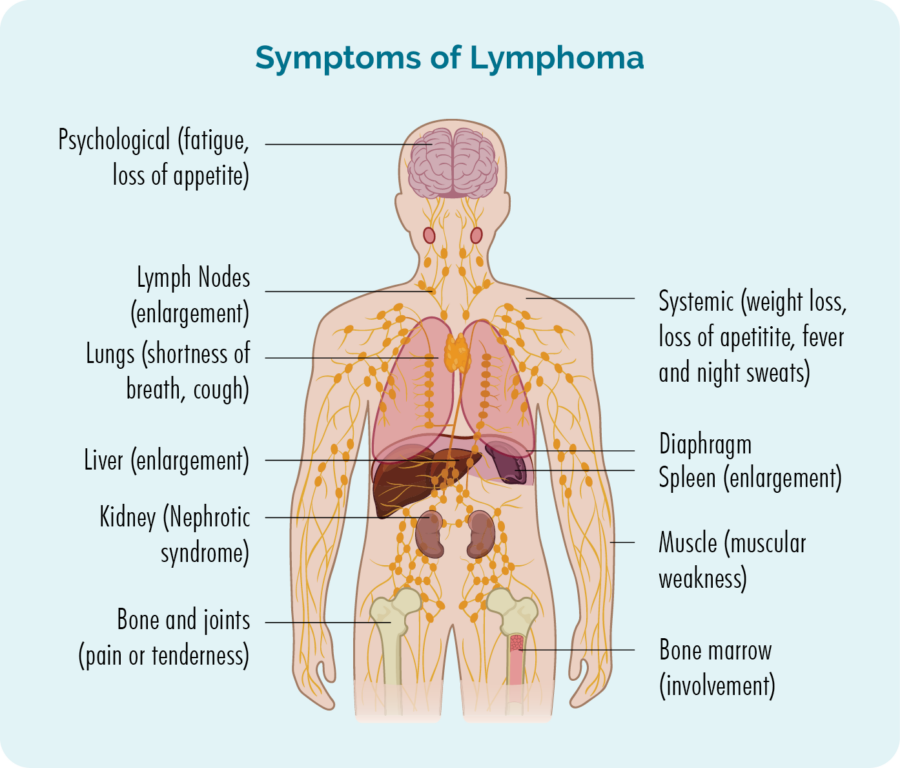
Some of these symptoms can be caused by the lymphoma pressing on a large vein in your chest called the superior vena cava (SVC). This vein carries all the blood from the upper half of your body to the heart. If pressure on the SVC blocks blood from flowing along it, doctors call this superior vena cava obstruction (SVCO).
General symptoms of Lymphoma
You may experience other symptoms that can affect anyone with any subtype of lymphoma. These can include:

- Swollen lymph nodes – a lump that you can see or feel. (In PMBCL this lump may be noticed in your chest, but can also be in your neck. armpit or groin).
- Feeling unusually tired (fatigued)
- Feeling out of breath
- Bruising or bleeding more easily than usual
- Infections that don’t go away, or keep coming back (recurrent)
- Sweating at night more than usual
- Losing your appetite (not wanting to eat)
- Losing weight without trying
- Itchy skin

How is Primary Mediastinal B-cell Lymphoma diagnosed?
Diagnosing PMBCL can sometimes be difficult and can take several weeks.
Your doctor will need to organise a number of important tests. These tests are needed to either confirm or rule out lymphoma as the cause for your symptoms. Because there are several different subtypes of lymphoma, you may have extra tests to find out which one you have. This is important because the management and treatment of your subtype may be different to other subtypes of lymphoma.
Blood tests
Blood tests are taken when trying to diagnose your lymphoma, but also throughout your treatment to make sure your organs are working properly and can cope with our treatment.
Biopsies
To diagnose PMBCL you will need a biopsy. A biopsy is a procedure to remove part, or all of an affected lymph node and/ or a bone marrow sample. The biopsy is then checked by scientists in a laboratory to see if there are changes that help the doctor diagnose PMBCL.
When you have a biopsy, you may have a local or general anaesthetic. This will depend on the type of biopsy and what part of your body it is taken from. There are different types of biopsies and you may need more than one to get the best sample.
To learn about the different types of biopsies that may be used to help diagnose PMBCL, click on the headings below.
Core or fine needle biopsies are taken to remove a sample of swollen lymph node or tumour to check for signs of PMBCL.
Your doctor will usually use a local anaesthetic to numb the area so you don’t feel any pain during the procedure, but you will be awake during this biopsy. They will then put a needle into the swollen lymph node or lump and remove a sample of tissue.
If your swollen lymph node or lump is deep inside your body the biopsy may be done with the help of ultrasound or specialised x-ray (imaging) guidance.
You might have a general anaesthetic for this (which puts you to sleep for a little while). You may also have a few stitches afterwards.
Core needle biopsies take a bigger sample than a fine needle biopsy.
Excisional node biopsies are done when your swollen lymph node or tumour are too deep in your body to be reached by a core or fine needle biopsy. You will have a general anaesthetic which will put you to sleep for a little while so you stay still, and feel no pain.
During this procedure, the surgeon will remove the whole lymph node or lump and send it to pathology for testing.
You will have a small wound with a few stitches, and a dressing over the top.
Stitches usually stay in for 7-10 days, but your doctor or nurse will give you instruction on how to care for the dressing, and when to return to have the stitches out.
When the biopsy is being taken from your mediastinum, you may need a type of keyhole surgery called a ‘mediastinoscopy‘ so the doctor can get a reliable sample.
During a mediastinoscopy you will be given a general anaesthetic so you will not be awake during the procedure. If you have hair on your chest, this may be shaved around the area the keyhole incisions (cuts) are made so it can be properly cleaned with an antiseptic to prevent any infections after surgery, and to make sure any dressing covering the wound stick to your skin properly.
The procedure
The surgeon will make one or more small incisions near or over your breastbone in the middle of your chest, and insert a tube with camera on the end so they can look into your chest and find the lymph node/s to take a biopsy from. When you wake up, you will likely have a couple of stitches and a wond dressing over the incision.
The biopsy will be sent the lab and you will be monitored for a few hours after the surgery to make sure there is no bleeding, your pain is under control and your vital signs – such as blood pressure, temperature and heart rate are all normal before being able to go home. You will not be able to drive and will need somebody to pick you up and stay with you for 24 hours because of the anaesthetic.
Staging of PMBCL
Once you have been diagnosed with PMBCL, your doctor will have more questions about your lymphoma. These will include:
- What stage is your lymphoma?
- What grade is your lymphoma?
Click on the headings below to learn more about staging and grading.
Staging refers to how much of your body is affected by your lymphoma – or, how far it has spread from where it first started.
B-cells can travel to any part of your body. This means that lymphoma cells (the cancerous B-cells), can also travel to any part of your body. You will need to have more tests done to find this information. These tests are called staging tests and when you get results, you will find out if you have stage one (I), stage two (II), stage three (III) or stage four (IV) PMBCL.
Your stage of PMBCL will depend on:
- How many areas of your body have lymphoma
- Where the lymphoma is including if it is above, below or on both sides of your diaphragm (a large, dome-shaped muscle under the rib cage that separates the chest from your abdomen)
- Whether the lymphoma has spread to your bone marrow or other organs such as the liver, lungs, skin or bone.
Stages I and II are called ‘early or limited stage’ (involving a limited area of your body).
Stages III and IV are called ‘advanced stage’ (more widespread).
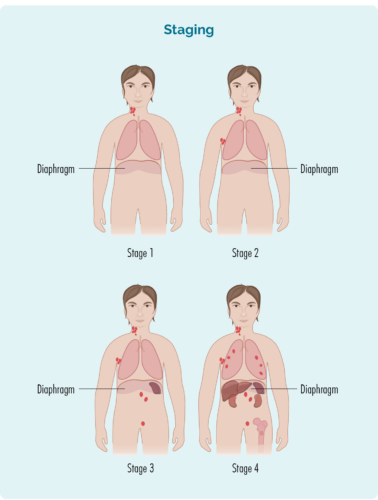
Stage 1 | one lymph node area is affected, either above or below the diaphragm* |
Stage 2 | two or more lymph node areas are affected on the same side of the diaphragm* |
Stage 3 | at least one lymph node area above and at least one lymph node area below the diaphragm* are affected |
Stage 4 | lymphoma is in multiple lymph nodes and has spread to other parts of the body (e.g. bones, lungs, liver) |
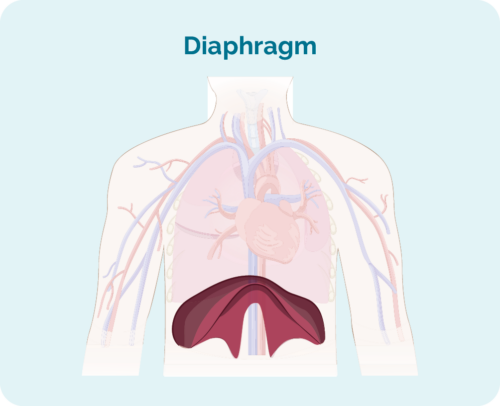
Extra staging information
Your doctor may also talk about your stage using a letter, such as A,B, E, X or S. These letters give more information about the symptoms you have or how your body is being affected by the lymphoma. All this information helps your doctor find the best treatment plan for you.
Letter | Meaning | Importance |
A or B |
|
|
E & X |
|
|
S |
|
(Your spleen is an organ in your lymphatic system that filters and cleans your blood, and is a place your B-cells rest and make antibodies) |
Tests for staging
To find out what stage you have, you may be asked to have some of the following staging tests:
Computed tomography (CT) scan
These scans takes pictures of the inside of your chest, abdomen or pelvis. They provide detailed pictures that provide more information than a standard X-ray.
Positron emission tomography (PET) scan
This is a scan that takes pictures of the inside of your whole body. You will be given and needle with some medicine that cancerous cells – such as lymphoma cells absorb. The medicine that helps the PET scan identify where the lymphoma is and the size and shape by highlighting areas with lymphoma cells. These areas are sometimes called “hot”.
Lumber puncture
A lumber puncture is a procedure done to check if you have any lymphoma in your central nervous system (CNS), which includes your brain, spinal cord and an area around your eyes. You will need to say very still during the procedure, so babies and children may have a general anaesthetic to put them to sleep for a little while the procedure is done. Most adults will only need a local anaesthetic for the procedure to numb the area.
Your doctor will put a needle into your back, and take out a little bit of fluid called “cerebral spinal fluid” (CSF) from around your spinal cord. CSF is a fluid that acts a bit like a shock absorber to your CNS. It also carries different proteins and infection fighting immune cells such as lymphocytes to protect your brain and spinal cord. CSF can also help drain any extra fluid you may have in your brain or around your spinal cord to prevent swelling in those areas.
The CSF sample will then be sent to pathology and checked for any signs of lymphoma.
Bone marrow biopsy
- Bone marrow aspirate (BMA): this test takes a small amount of the liquid found in the bone marrow space.
- Bone marrow aspirate trephine (BMAT): this test takes a small sample of the bone marrow tissue.
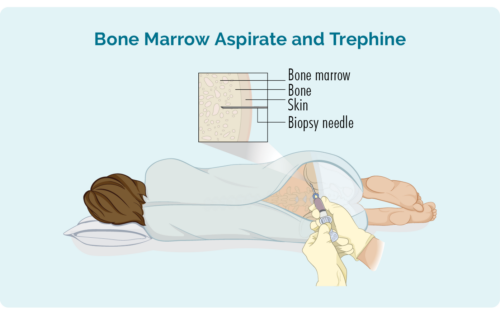
The samples are then sent to pathology where they are checked for signs of lymphoma.
How will my pain be managed during the procedure?
The process for bone marrow biopsies can differ depending on where you are having your treatment, but will usually include a local anaesthetic to numb the area.
In some hospitals, you may be given light sedation which helps you to relax and can stop you from remembering the procedure. However many people do not need this and may instead have a “green whistle” to suck on. This green whistle has a pain killing medication in it (called Penthrox or methoxyflurane), that you use as needed throughout the procedure.
Make sure you ask your doctor what is available to make you more comfortable during the procedure, and talk to them about what you think will be the best option for you.
More information on bone marrow biopsies can be found at our webpage here.
Your lymphoma cells have a different growth pattern, and look different to normal cells. The grade of your lymphoma is how quickly your lymphoma cells are growing, which affects the way look under a microscope. The grades are Grades 1-4 (low, intermediate, high). If you have a higher-grade lymphoma, your lymphoma cells will look the most different from normal cells, because they are growing too quickly to develop properly. An overview of the grades is below.
Slower growing lymphomas are called indolent, while fast growing lymphomas are called aggressive.
Grades of lymphoma
- G1 – low grade – your cells look close to normal, and they grow and spread slowly.
- G2 – intermediate grade – your cells are starting to look different but some normal cells exist, and they grow and spread at a moderate rate.
- G3 – high grade – your cells look fairly different with a few normal cells, and they grow and spread faster.
- G4 – high grade – your cells look most different to normal, and they grow and spread the fastest.
What grade is PMBCL?
PMBCL is a high-grade, aggressive lymphoma. Many people are diagnosed at an advanced stage because of how quickly it grows and spreads, however you can still be cured from advanced stage aggressive PMBCL. Lymphoma is very unlike advanced solid tumours cancers such as bowel or lung cancer.
All this information adds to the whole picture your doctor builds to help decide the best type of the treatment for you.
Talk to your doctor about your own risk factors so you can have clear idea of what to expect from your treatments.
Understanding your lymphoma genetics
When your biopsies are sent to the lab, the pathologist may do extra tests called cytogenetics.

Cytogenetic tests are done to check for genetic variances that may be involved in your disease. For more information on these please see our section on understanding your lymphoma genetics further down on this page. The tests used to check for any genetic mutations are called cytogenetic tests. These tests look to see if you have any changed in chromosomes and genes.
We usually have 23 pairs of chromosomes, and they are numbered according to their size. If you have PMBCL, your chromosomes may look a little different.
What are genes and chromosomes
Each cell that makes up our body has a nucleus, and inside the nucleus are the 23 pairs of chromosomes. Each chromosome is made from long strands of DNA (deoxyribonucleic acid) that contain our genes. Our genes provide the code needed to make all the cells and proteins in our body, and tells them how to look or act.
What happens if there is a change to my genes or chromosomes?
If there is a change (also called a variation or a mutation) in these chromosomes or genes, your proteins and cells will not work properly, and lymphocytes can become lymphoma cells due to the changes within the cells.
Some of the genetic changes that have been found in people with PMBCL have resulted in certain proteins called PDL1 and PDL2 growing on the lymphoma cells (These proteins are also called “immune checkpoints”. These proteins are normally found on healthy cells and are your bodies way of identifying healthy cells. By growing these proteins on them, lymphoma cells can ‘pretend’ to be normal healthy cells, so your immune system does not recognise them as harmful, and instead lets them continue growing and spreading.
Other genetic changes may interrupt the normal pathways cells take when they damaged to repair or destroy themselves and so they can continue to develop abnormally and create more abnormal (cancerous lymphoma) cells.
Treatment for Primary Mediastinal B-cell Lymphoma
Once all of your results from the biopsy, cytogenetic testing and the staging scans have been completed, the doctor will review these to decide the best possible treatment for you. At some cancer centres, the doctor will also meet with a team of specialists to discuss the best treatment option. This is called a multidisciplinary team (MDT) meeting.
Your doctor will consider many factors about your PMBCL. Decisions on when or if you need to start and what treatment is best are based on:
- Your individual stage of lymphoma, genetic changes and symptoms
- Your age, past medical history and general health
- Your current physical and mental wellbeing and patient preferences
More tests may be ordered before you start treatment to make sure your heart, lungs and kidneys are able to cope with the treatment. These may include an ECG (electrocardiogram), lung function test or 24-hour urine collection.
Your doctor or cancer nurse can explain your treatment plan and the possible side-effects to you and are there to answer any questions you might have. It is important you ask your doctor and/or cancer nurse questions about anything you don’t understand.
 Fertility preservation
Fertility preservation
Some cancer treatments can make it harder to fall pregnant or to get someone pregnant. If you (or your child) are planning to have children at a later point, talk to your doctor about how to preserve your fertility.
You can also phone or email the Lymphoma Australia Nurse Helpline with your questions and we can help you to get the right information.
Lymphoma Care Nurse Hotline
Phone: 1800 953 081
Email: nurse@lymphoma.org.au
Questions to ask your doctor before you start treatment
It can be difficult to know what questions to ask when you are starting treatment. If you don’t know, what you don’t, how can you know what to ask?
Having the right information can help you feel more confident and know what to expect. It can also help you plan ahead for what you may need.
We have put together a list of questions you may find helpful. Of course, everyone’s situation is unique, so these questions do not cover everything, but they do give a good start. Click on the link below to find a PDF copy that you can download and print.
Click on the link below to download a printable PDF of questions for your doctor.
Types of anticancer treatment for PMBCL
Primary Mediastinal B-cell Lymphoma (PMBCL) is a fast-growing (aggressive) lymphoma, so you will need to start treatment quickly – usually within 1-3 weeks of being diagnosed.
Treatment may include a combination of different medicines, including chemotherapies, monoclonal antibodies (MABs), immune checkpoint inhibitors (ICIs), and radiation treatment.
Click on the headings below to learn more about some of the different treatment options you may be offered.
Supportive care is given to patients and families facing serious illness and can help you have fewer symptoms, or get better faster by making sure you get what you need for your body to as effectively as possible.
Improving blood cell counts
Treatments for PMBCL can affect your good blood cells which can result in you not having enough healthy blood cells to keep you well. As a result, you may be offered a transfusion with packed red blood cell or platelets to improve your levels of these blood cells. If your white blood cells are too low – or are expected to get too low, you may be offered an injection that goes into your tummy which helps stimulate your bone marrow to produce more of these cells. You may also need antibiotics if you do get an infection while your white cells are too low, to help you fight off any infections.
Managing symptoms and planning healthcare
Supportive care may also including seeing different specialist with expertise in other areas of your health or planning for future care such as helping you create an Advanced Care Plan to outline your wishes for you health care in the future. If you have symptoms or side-effects that are not improving, you may be offered a consultation with the palliative care team who are specialists in managing difficult to treat symptoms such as pain and nausea not improved with standard treatments. These things are part of multidisciplinary management of lymphoma.
Radiation therapy is a cancer treatment that uses high doses of radiation to kill lymphoma cells and shrink tumours. Before having radiation, you will have a planning session. This session is important for the radiation therapists to plan how to target the radiation to the lymphoma, and avoid damaging healthy cells. Radiation therapy usually lasts between 2-4 weeks. During this time, you will need to go to the radiation centre everyday (Monday-Friday) for treatment.
Important note
If you live a long way from the radiation centre and need help with a place to stay during treatment, please talk to your doctor or nurse about what help is available to you. You can also contact the Cancer Council or Leukemia Foundation in your state and see if they can help with somewhere to stay.
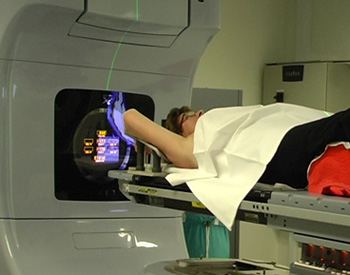
You might have these medications as a tablet and/ or be given as a drip (infusion) into your vein (into your bloodstream) at a cancer clinic or hospital. Several different chemo medications may be combined with an immunotherapy medicine. Chemo kills fast growing cells so can also affect some of your good cells that grow fast causing side effects.
You may have a MAB infusion at a cancer clinic or hospital. MABs attach to the lymphoma cell and attract other diseases fighting white blood cells and proteins to the cancer so your own immune system can fight the PMBCL.
MABS will only work if you have specific proteins or markers on your lymphoma cells. A common marker in PMBCL is CD20. If you have this marker you may benefit from treatment with a MAB.
Immune checkpoint inhibitors (ICIs) are a newer type of monoclonal antibody (MAB) and work a little differently to other MABS.
ICIs work when your tumour cells develop “immune checkpoints” such as PDL1 or PDL2 on them which are usually only found on your healthy cells. The immune checkpoint tells your immune system that the cell is healthy and normal, so your immune system leaves it alone.
ICIs work by blocking the immune checkpoint so your lymphoma cells can no longer pretend to be healthy, normal cells. This allows your own immune system to recognise them as cancerous, and begin an attack against them.
Pembrolizumab is an example of an immune checkpoint inhibitor used in PMBCL.
Chemotherapy combined with a MAB (for example, rituximab).
A stem cell or bone marrow transplant is done to replace your diseased bone marrow with new stem cells that can grow into new healthy blood cells. Bone marrow transplants are usually only done for children with PMBCL, while stem cell transplants are done for both children adults.
CAR T-cell therapy is a newer treatment that will only be offered if you have already had at least two other treatments for your PMBCL.
In some cases, you may be able to access CAR T-cell therapy by joining a clinical trial.
CAR T-cell therapy involves an initial precodure similar to a stem cell transplant, where your T-cell lymphocytes are removed from you blood during an apheresis procedure. Like you B-cell lymphocytes, T-cells are part of your immune system and work with your B-cells to protect you from disease and illness.
First-line treatment
You will need to start treatment soon after all your test results come back. In some cases, you may start before all the test results are in.
It can be quite overwhelming when you start treatment. You may have many thoughts about how you will cope, how to manage at home, or how sick you might get.
Let your treating team know if you feel you may need extra support
They may be able to help by referring you to see a social worker or other health care professional to help you work out some everyday living challenges you may face. You can also reach out to the Lymphoma care nurses by clicking on the “Contact us” button at the bottom of this page.
When you do start treatment for the first time, it is called ‘first-line treatment’. You may have more than one medicine, and these may include chemotherapy, a monoclonal antibody or targeted therapy. In some cases you may have radiation treatment or surgery as well, or instead of medications.
Treatment cycles and protocols
When you have these treatments, you will have them in cycles. That means you will have the treatment, then a break, then another round (cycle) of treatment. For most people with PMBCL, chemoimmunotherapy is effective to achieve a remission (no signs of cancer).
Standard first-line treatment for PMBCL may include:
R-CHOP is common treatment for PMBCL and includes combination of rituximab (a MAB) with three chemotherapy medicines – cyclophosphamide, doxorubicin and vincristine. You will also have a steroid called prednisolone. R-CHOP is usually given in one day every 14 or 21 days.
On the fourth day after treatment, you will also have an injection in your tummy to help your white blood cells grow back quicker.
Includes the same medications as R-CHOP but with the addition of another chemotherapy called etoposide. This protocol is given in different doses depending on your individual situation. The DA in the name means “dose adjusted”. It is given over a five-day period every 21 days. On the sixth day, you will also have an injection in your tummy to help your white blood cells grow back quicker.
Some genetic abnormalities may mean that targeted therapies will work best for you, and other genetic abnormalities – or normal genetics may mean chemoimmunotherapy will work best.
This is a chemotherapy, and may be given to you if you have, or at risk of getting PMBCL in your brain or spinal cord. The doctor will give you a needle in your back (under sterile conditions) and inject the methotrexate into the fluid surrounding your spinal cord. You may have this with either R-CHOP or DA-R-EPOCH.
As mentioned above
These may include targeted therapies and other treatments. Ask your doctor if are eligible for any first-line treatment clinical trials.
Second-line therapy
After treatment most of you will go into remission. Remission is a period where you have no signs of PMBCL left in your body, or when the PMBCL is under control and doesn’t require treatment. Remission can last for many years, but sometimes PMBCL may ‘relapse’ (come back). When this happens, you will need to start treatment again, however it may be different from the treatment you had in the past.
Very rarely, some people may not respond to first-line treatment or go into remission. If this happens, your PMBCL is called ‘refractory’. When you have refractory PMBCL your doctor will want to try a different type of medication.
Treatment you have if you have relapsed or refractory PMBCL is called second-line treatment. The goal of second-line treatment is to put you into remission again. If you have further remission, then relapse and have more treatment, these next treatments are called third-line treatment, fourth-line treatment and so on.
How does the doctor choose the best treatment for relapsed or refractory PMBCL?
At the time of relapse, the choice of treatment will depend on several factors including:
- How long you were in remission for
- Your general health and age
- What PMBCL treatment/s you have received in the past
- Your preferences.
Common second-line and later-line treatments for PMBCL may include:
A stem cell transplant
A stem cell transplant may be offered to you if you have relapsed, however it is not suitable for everyone. Your doctor will consider several things before deciding if this is a suitable option for you.
Click on the Stem cell transplants below for more information.
Pembrolizumab
An immune checkpoint inhibitor (ICI), it is given as a monotherapy for refractory PMBCL, or following two prior therapies for relapsed PMBCL (not available on the PBS). Pembrolizumab can be effective if your lymphoma cells have the immune checkpoints PDL1 or PDL2 on them.
Chimeric antigen receptor T-cell therapy (CAR T-cell therapy)
CAR T-cell therapy is currently only approved for people who have already had at least two different types of treatment for their PMBCL. For more information on CAR T-cell therapy click the link below.
Clinical trial participation
It is recommended that anytime you need to start new treatments you ask your doctor about clinical trials you may be eligible for.
Side-effects of lymphoma treatment
There are many different side-effects of treatment, and they can be different between people and treatment types. Your doctor and nurse will go over what you may experience before you start treatment.
Some side-effects can include:
- Changes to you blood counts
- Feeling sick in the stomach (nausea) and/or vomiting
- Sore mouth (mucositis); you may also notice a change in the taste of food and drinks
- Bowel problems such as constipation or diarrhoea
- Tiredness or a lack of energy not helped by rest or sleep (fatigue)
- Muscle aches and pains (myalgia)
- Joint aches and pains (arthralgia)
- Hair loss and/or thinning (alopecia)
- Mind fogginess and difficulty in remembering things (‘chemo brain’)
- Changed sensation in your hands and feet such as tingling, pins and needles or pain (neuropathy)
- Reduced fertility or early menopause (change of life).
For more information on side-effects click the link below.
What happens after treatment?
Sometimes a side effect from treatment may continue or develop months or years after treatment has completed. This is called a late effect.
Finishing treatment
This can be a challenging time for many people and some of the common concerns can be related to:
- Physical
- Mental wellbeing
- Emotional health
- Relationships
- Work, study and social activities
What is the prognosis for PMBCL?
Prognosis is the term used to describe the likely path of your disease, how it will respond to treatment and how you will do during and after treatment.
There are many factors that contribute to your prognosis and it’s not possible to give an overall statement about prognosis. However, PMBCL often responds well to treatment and many people diagnosed can be cured – meaning after treatment there is no sign of PMBCL in your body, or have long-lasting remissions.
Factors that can impact prognosis
Some factors that may impact your prognosis include:
- Your age and overall health at the time of diagnosis
- How you respond to treatment
- What, if any, genetic mutations you have
If you would like to know more about your own prognosis, please talk with your specialist haematologist – they will be able to explain your risk factors and prognosis to you.
Survivorship – Living with and after PMBCL
A healthy lifestyle, or some positive lifestyle changes after treatment can be a great help to your recovery. There are many things you can do to help you live well with PMBCL.
Many people find that after a cancer diagnosis, or treatment, that their goals and priorities in life change. Getting to know what your ‘new normal’ is can take time and be frustrating. Expectations of your family and friends may be different to yours. You may feel isolated, fatigued or any number of different emotions that can change each day.
Goals after treatment
The main goals after treatment for your PMBCL is to get back to life and:
- be as active as possible in your work, family, and other life roles
- lessen the side effects and symptoms of the cancer and its treatment
- identify and manage any late side effects
- help keep you as independent as possible
- improve your quality of life and maintain good mental health
Cancer Rehabilitation
Different types of cancer rehabilitation may be recommended to you. This could mean any of a wide range of services such as:
- physical therapy, pain management
- nutritional and exercise planning
- emotional, career and financial counselling.
Other resources for you
Summary
- Primary Mediastinal B-cell Lymphoma (PMBCL) is a subtype of Diffuse Large B-cell Lymphoma (DLBCL) – a type of Non-Hodgkin Lymphoma.
- PMBCL is named because this lymphoma starts in your mediastinum – in your chest cavity.
- Many symptoms are related to the growing tumour in your chest putting pressure on your airways, lungs or other organs in your chest.
- B-symptoms are a group of symptoms that can happen when you have PMBCL. You need to let you doctor know if you get these.
- PMBCL is an aggressive lymphoma so you need to start treatment soon after diagnosis but, even advanced stage 3 or 4 PMBCL may be cured.
- PMBCL can relapse, so you may need treatment more than once.
- Our Lymphoma Care Nurses are available to chat to about your diagnosis, treatment and resources available to you. Click on the Contact Us button at the bottom of the screen for details.
